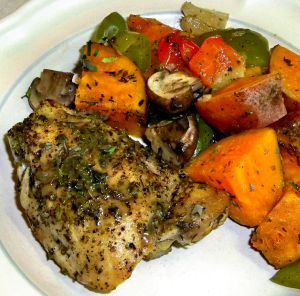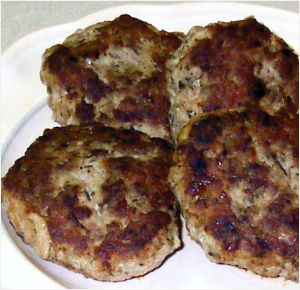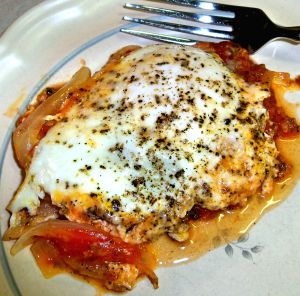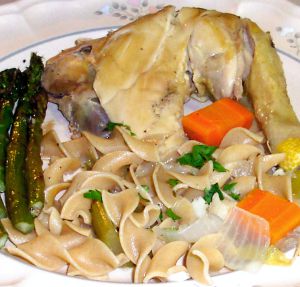Al Dente - Literally, "to the tooth" in Italian. Foods cooked to the point that there is still some resistance; tender, but slightly chewy. Used mostly in reference to pasta, which should be cooked al dente, no softer, for most recipes.
Baste - To add moisture, flavor and color to foods by brushing, drizzling or spooning pan juices or other liquids over the food at various times during the cooking process. This is especially essential when cooking with dry heat, such as oven roasting or grilling.
Beat - To mix thoroughly with a spoon, whisk or beaters until well-combined and very smooth.
Blanche - To partially cook food, usually vegetables or fruit, in boiling water or steam. Immediately after blanching, vegetables are usually placed in ice water to stop the cooking and set the color.
Blend - To mix ingredients just until thoroughly combined. Not originally meant to be prepared in a blender, but can be in some recipes.
Boil - To heat liquids until bubbles form on the surface, and then to keep it at that temperature during the cooking process.
Braise - To cook slowly in a small amount of liquid in a covered pot. Foods are usually browned prior to braising to add flavor. Braising can be done on top of the stove or in an oven, depending on the recipe.
Bread - The process of adding a coating to foods, usually for frying or baking. The food is usually first dipped in flour, then a mixture of egg and water, and finally very fine bread crumbs, corn meal or cracker crumbs. It's a good idea to let the coated food refrigerate for at least 30 minutes before frying to ensure that the coating will stick.
Brown - Generally, when a recipe says to "brown", it refers to cooking quickly in a hot pan, on the grill or under a broiler until all sides turn golden or brown in color. The purpose is to seal in the juices and add flavor.
Butterfly - A method of cutting meats so that it will lay flat and even. It is difficult to describe without visual effects, but the meat is sliced in the center, without going all the way through, and opened to lay flat like the wings of a butterfly. In larger cuts, it is sliced in increments from middle to either side, and the flaps are opened like the pages of a book.
Caramelize - The process through which natural sugars in foods become browned and flavorful while cooking. This is usually done over a constant heat of low to medium-low. Caramelization can be quickened with the addition of a little sugar. Either way, be careful not to burn.
Chiffonade - Finely shredded vegetables, usually herbs, most often to be used as a garnish.
Chop - To cut foods into small pieces. Sizes vary from fine (approximately 1/4-inch pieces) to coarse (approximately 3/4-inch pieces). In most recipes, precision is not necessary.
Clarify - To make a liquid clear, as with butter. Unsalted butter is melted over low heat until the milk solids come to the top. They are then removed. Without the milk solids, the butter can be used in recipes in which you don't want it to brown.
Coddle - To cook gently just below the boiling point. Most commonly refers to eggs, where the egg is cooked for 1 minute in the shell.
Congeal - To turn liquid into solid by chilling.
Cream - To beat an ingredient or ingredients with a spoon or beaters until light and fluffy. Most often used in reference to butter or shortening, with or without sugar, in baking recipes.
Cube - Cut into squares, size of which is determined by the recipe, generally between 1/2 to 2-inches.
Cut in - To work a solid fat, such as butter, shortening or lard, into dry ingredients. This is accomplished by using a pastry blender, 2 knives, a fork, or even the fingers. Most often, the fat should be chilled first and cut in just enough for small lumps about the size of a pea to form.
Dash - If a recipe calls for "a dash" of an ingredient, it is somewhat relative. However, the most accurate amount appears to be 1/16-teaspoon. Literally, you just add the ingredient "in a dash". For example, if it is a dry ingredient, such as a spice, just shake the box once, assuming there are small holes, and what comes out is it. It is the same with liquid ingredients that come out in drops. Remember, many of those types of ingredients are to taste, so a tiny bit more or less will not matter.
Debone - To remove the bones from meat or poultry. This is best done with a flexible boning knife so that you can get as close to the bone as possible without losing meat. If in doubt, get a good cookbook that shows the process in stages, or watch a good, informative cooking show. Your butcher will also do it for you, but it is fun to learn how.
Deep fry - To fry foods rapidly in a deep pot of oil so that the food is totally submerged. The oil should never come up much more than half way in the pot, and should be a type with a high smoking point.
Deglaze - The process of scraping up all the fond, the browned bits that collect in the bottom of a pan or skillet after browning or cooking. Liquid is added to the pan and, as it heats up, the bottom is scraped with a spoon or spatula so that the residue is added back into the liquid for a lot of extra flavor.
Dice - To cut into very small pieces, approximately 1/8 to 1/16-inch.
Dredge - To coat before cooking with dry ingredients such flour, corn meal, bread or cracker crumbs, or other mixtures. Sweet items are sometimes dredged with sugar and/or spices, such as cinnamon, after baking or frying.
Dust - To sprinkle lightly before or after cooking with dry ingredients, such as flour, granulated or confectioners' sugar or spices.
Emulsify - To bind together liquid ingredients that do not dissolve into each other. Most common is oil into vinegar or citrus juice to make a vinaigrette. The oil is poured very slowly into the acid while whisking or blending vigorously, until the mixture is thickened and the liquids become one.
Fillet - To remove bones from a fish, so that only the flesh remains. The process depends on the type of fish. Though similar, it is different for flat fish, like a flounder, or round fish, such as a trout. The best way to learn how is to purchase a cookbook with details or watch the cooking shows. If in doubt, your seafood monger will do it for you.
Flake - To gently separate into small pieces, usually with a fork or your fingers. Most commonly refers to cooked fish which, because of its texture, flakes easily.
Fold - To gently mix two or more ingredients together, where one is usually heavier than the other, in order to combine but preserve the texture of each. For example, to combine whipped cream or beaten egg whites with a heavy batter without deflating. First, stir a little of the whipped product into the batter to lighten it. Then add the remainder. Cut through the center with a rubber spatula, move across the bottom of the bowl towards the side, and gently bring up some of the heavy mixture. Continue, turning the bowl slightly each time, until combined. It is acceptable to leave a few streaks of egg whites when beating them into a batter.
Fry - To cook and brown food in a specified amount fat, usually done very quickly so that a minimal amount of the fat is absorbed into the food. See also: deep fry; shallow fry.
Garnish - To enhance finished foods with flavor or visual appeal by using other edible products on the plate. The most common are herbs or grated cheese, but there are many other possibilities including, but not limited to, fruits, small vegetables and edible flowers.
Glaze - The process of dipping or brushing, usually with a sugar-based liquid, to give flavor and a shiny finish to foods, such as roasted or grilled meats, fried pastries or baked goods.
Grate - To rub foods, such as cheeses, vegetables, citrus skins, spices or chocolate, against a grater. Alternately, you can use a processor or mixer blade. Size of grate is dependent upon recipe and/or taste.
Grind - To process foods finely in a grinder, processor or with 2 knives (in a drum roll fashion). Some examples are ground beef for hamburger or ground pork for sausage, but there are preparations other than meats. The advantage of grinding your own is that you can control the texture (from fine to coarse), fat, seasonings and bacteria that can sometime form in excessively or improperly handled processed foods. That being said, be certain you know how to handle the foods safely while grinding.
Julienne - To slice foods in sticks, usually about 1/8-inch wide and 2-inches long. This can easily be accomplished with a knife by stacking slices, then cutting down very thinly. You can also use a mandolin, processor or electric mixer blade attachment.
Knead - The process of working a dough to activate the gluten, which is the protein in flour that makes the dough cohesive. To knead by hand, place the dough on a lightly floured surface. Using the heel of the hand, press down on the dough in a forward motion. Then fold the dough over and press again. Continue the process until the dough is very smooth and elastic. For most recipes, it will take about 10 minutes. Alternately, the dough can be kneaded in a processor or heavy-duty standing mixer with a dough hook. Some recipes specify a very light kneading, so follow the instructions carefully.
Leaven - To add an ingredient, such as yeast, baking powder or baking soda, that adds gas to a dough or batter, causing it to expand, or rise, and lighten the texture of the finished product.
Macerate - To add liquid to food, or an ingredient, such as sugar, that causes liquid to form, in order to soften and enhance flavor after it sets for a given amount of time. Usually used in reference to fresh fruits.
Marinate - To add liquid or dry ingredients to food that enhance flavor and/or tenderize after it sets for a given amount of time. Usually used in reference to meats and vegetables. Liquid marinades often include an acid, such as vinegar, wine or citrus juice, mixed with herbs, spices and oil. Dry marinades are usually in the form of spice and herb rubs.
Mince - To cut into extremely fine pieces.
Mix - To combine ingredients with a spoon, beaters or hands until well incorporated.
Pan fry - To brown and cook foods in fat in a shallow pan, where the fat does not completely cover the food. Also known as 'shallow fry'.
Pare - To remove skins and peels from fruits or vegetables with a small knife or peeler.
Parboil - To partially cook for a given amount of time in boiling water as a preliminary step.
Pat - To take the underside of the hand and gently press a food. The purpose might be to pat dry ingredients onto the surface so they will adhere during cooking, or to pat with a towel to remove excess moisture.
Pinch - As much of an ingredient that can be held between the thumb and forefinger. A very small, approximate amount.
Pit - To remove the seed from a piece of fruit by cutting around the sides of the fruit and pulling the seed away from the flesh.
Poach - To cook food in gently simmering, never boiling, liquid.
Preheat - To heat the oven to the specified temperature before adding the foods. Most recipes require preheating of the oven. Usually the recipe will indicate if the oven should not be preheated.
Proof - To activate yeast, or other leavening agent, before using in a recipe. The yeast is normally added to a liquid, possibly mixed with sugar, and allowed to set a given amount of time until it bubbles. If it doesn't bubble, it is old and should be discarded.
Pulse - An action used with processors and blenders. If a recipe tells you to pulse, turn the start button on and off rapidly several times or until the ingredients are appropriately processed.
Punch down - To deflate a risen dough. With your hand, press on the dough until the gas escapes.
Purée - To process foods into a smooth substance of varying degrees of thickness as dictated by the recipe. Usually done with a blender, processor, sieve or food mill.
Reconstitute - To restore condensed or concentrated foods to their original strength with the addition of liquid, usually water.
Reduce - To rapidly boil a liquid until it partially evaporates, leaving a thicker texture and a more intense flavor.
Refresh - To restore by placing in water. Most commonly used in reference to blanched vegetables that are placed immediately in ice water to stop the cooking, set the color and restore the crispness. Greens and herbs that are still very fresh but have gone limp can be restored to the original state by placing in cold (not ice) water and then patted dry.
Ribbon - Used in reference to beating a mixture, usually egg yolks and sugar, until it is thick enough to form a ribbon. Lift the beaters out of the bowl and let the excess mixture drip down into the bowl. When it forms a ribbon shape on top of the mixture in the bowl, it is ready.
Sauté - Literally means "to jump", as to jump in the pan. To quickly fry foods in a little fat, usually oil or butter, in an open skillet over medium-high to high heat, turning or tossing often, until tender and lightly browned, as dictated by the recipe.
Scald - To heat milk or cream to a temperature just before it boils without allowing it to boil. Tiny bubbles will form around the outer edge when it is ready.
Score - To cut slits into foods before cooking for various purposes, including decoration, ease of cutting after cooking, tenderization or to allow flavors to penetrate the surface. Additionally, the fat layer of a large cut of meat, as well as smaller cuts with a fatty outer layer, such as duck breasts, is often scored so that some of the fat melts out during roasting.
Sear - To cook meats quickly on all sides over high heat to brown and seal in the juices. The meat should not be turned until it is well browned on each side or it will stick to the pan.
Shallow fry - To fry with a lesser amount of oil than what is required for deep frying. The food is partially submerged in the oil and must be turned halfway through cooking. This is especially useful with thinner cuts of meat and seafood, such as cutlets and fish fillets.
Shred - To cut, slice or tear into thin strips. Also, to pull apart very tender cooked meats, usually with a fork.
Sift - To pass a dry ingredient through a sifter or fine mesh screen to loosen the particles, incorporate air, and lighten the resulting product. Also used to combine several ingredients that are passed through at the same time. The same result can be accomplished by using a wire whisk to stir the ingredients in a bowl. If a recipe calls for presifted ingredients, sift first and then measure. If it calls for a certain amount of the ingredient, sifted, measure first. Presifted flour out of the bag must still be sifted if the recipe calls for it.
Simmer - To cook gently just below the boiling point. If the food starts boiling, the heat is too high and should be reduced.
Skim - To remove an undesirable substance that forms on the top surface of a liquid, usually fat, foam or scum. This is normally done by passing a flat spoon over the surface, just underneath the substance to discard. In the case of fat, if you have the time, chill the liquid first so that the fat congeals, making it very easy to remove.
Steam - A method of cooking foods over, not in, hot liquid, usually water. The heat cooks the food while the vapors keep it moist. Steaming is a good alternative to boiling because none of the nutrients or flavor is lost in the liquid. Food can also be steamed in a microwave.
Steep - To soak a food in liquid for a given amount of time. Sometimes, the liquid is hot, as in tea. Other times, as with macerated fruit, the liquid is cold or room temperature.
Stew - To cook foods slowly in a specified amount of liquid in a covered pot or pan.
Stir - To move foods around with a spoon in a circular motion. Stirring is done to move foods when cooking. It is also used to cool foods after cooking. Most importantly, if a recipes calls for stirring to combine foods, such as a batter, before cooking, it usually means to gently mix just until well combined, as opposed to beating, which takes more strokes.
Stir-fry - To quickly cook foods over high or medium-high heat in a lightly oiled skillet or wok, stirring or tossing constantly, until desired or specified doneness.
Strain - To pass a liquid or moist mixture through a colander, sieve or cheese cloth to remove solid particles.
Sweat - To cook foods, usually chopped vegetables, over medium heat until they exude some of their moisture which, in turn, steams and softens the food without browning.
Temper - Technically, to moderate. In cooking, tempering most often refers to slightly warm beaten eggs by rapidly stirring a little of the hot ingredients into them before adding the eggs to the hot mixture so that they will combine, stirring rapidly again, without solidifying. It also refers to the softening of a heavy mixture before folding in a whipped mixture, so that incorporation occurs without deflation.
Toast - Most commonly, to brown using a dry heat source such as an oven or toaster. However, many recipes call for toasting seeds, nuts, grains or spices before mixing with other ingredients to add flavor. They can be toasted in an oven or in a skillet, with or without oil, using a low heat, stirring or tossing often, until nicely browned, being very careful not to burn.
Toss - To combine ingredients by gently turning over until blended. Most commonly refers to a salad, but is used for many other preparations. The easiest and most efficient way to toss is with a good pair of tongs. Alternately, two spoons, forks or one of each may be used. And nothing tosses food as well as a clean pair of hands.
Truss - To shape food into a desired form and secure with butcher's twine or skewers. Most commonly used with poultry or meats. In the case of poultry, it is questionable whether or not it should be trussed because, although it gives a nice look to the bird after roasting, the breast tends to cook faster than the legs, thighs and wings, so always truss lightly.
Whip - To beat briskly with a wire whisk or electric mixer to incorporate air, which adds volume and an airy texture. Usually used in reference to cream or egg whites. To whip cream, which has fat, always chill the bowl, beaters and cream first. Egg whites, which are mostly water, should be whipped at room temperature in a very clean bowl so as not to add any fat to the whites.
Whisk - To mix to the specified state with a wire beater, also called a whisk. Whisking can refer to blending, beating, emulsifying, or whipping, depending on the recipe. Flour can also be whisked to achieve the same texture as sifting.
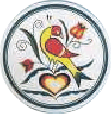
No matter where I take my guests, it seems they like my kitchen best.
Pennsylvania Dutch Saying
This site may not be reproduced in whole or in part without written permission and appropriate credit given. Written, designed and maintained by Teri Ranck Foster. All rights reserved. Copyright Statement, Privacy Policy and Disclaimers.

